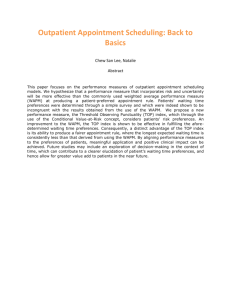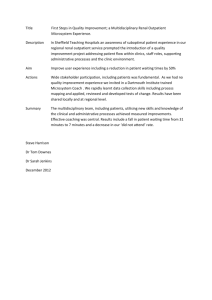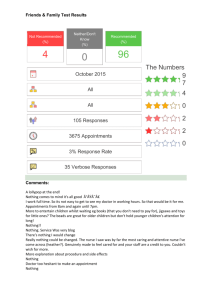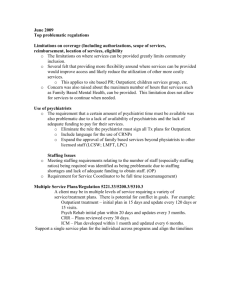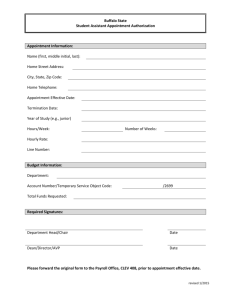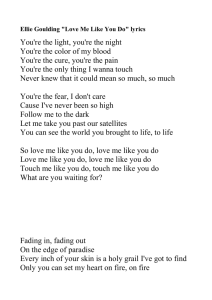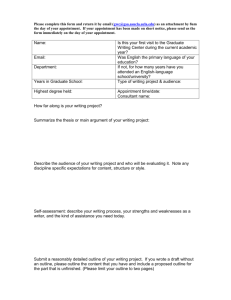Trust Board: Wednesday 9 July 2014 Title Patient Story
advertisement
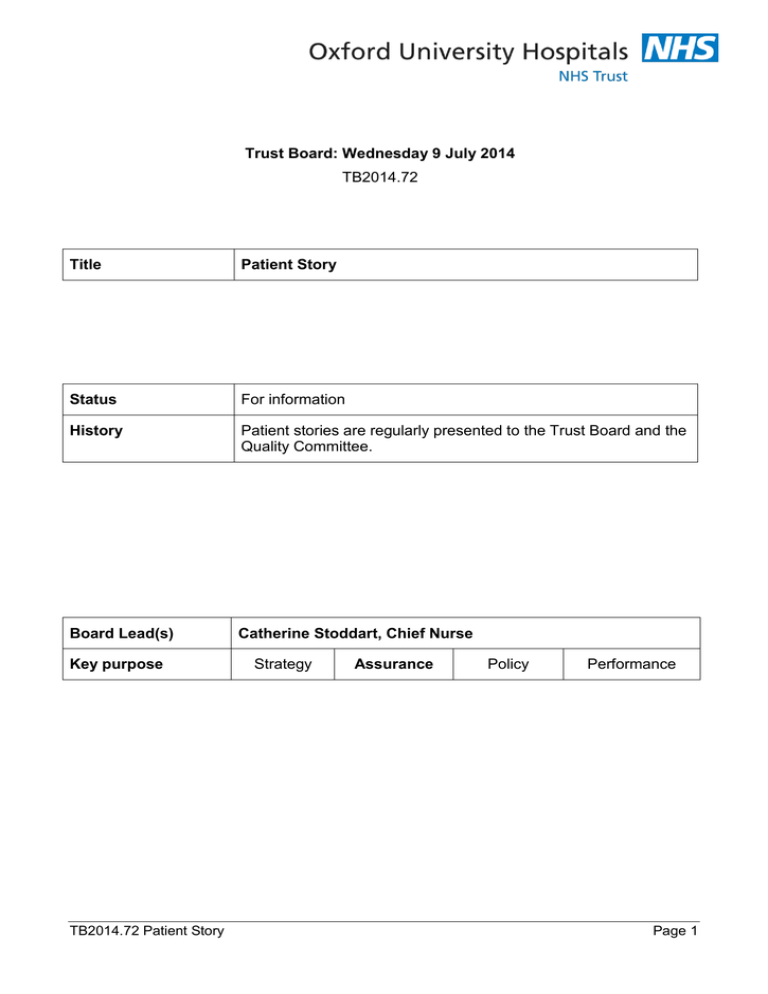
Trust Board: Wednesday 9 July 2014 TB2014.72 Title Patient Story Status For information History Patient stories are regularly presented to the Trust Board and the Quality Committee. Board Lead(s) Catherine Stoddart, Chief Nurse Key purpose TB2014.72 Patient Story Strategy Assurance Policy Performance Page 1 Oxford University Hospitals TB2014.72 Executive Summary 1. Ms H visited the Eye Hospital in October 2013 to accompany her mother, who has impaired vision and hearing, for an outpatient appointment. Ms H found that access to Eye Hospital could be improved and the environment in the outpatients department presented a number of obstacles for people with mobility, visual and hearing impairments. 2. This patient story was selected based on the criteria previously approved at Quality Committee for the selection of stories; as the story highlights key issues for organisational learning in relation to Physical access for patients and relatives with reduced mobility. The provision for alternative and enhanced methods of communication for patients and relatives. Ensuring staff are confident in their ability to approach people with disabilities and facilitate adjustments for people who need them. The proactive notification of patient’s specific needs prior to accessing the Trust’s services. 3. The Trust hosted a patient and public engagement event on the 24th April 2014 with the focus of gaining information and feedback on outpatient services. The key themes within the feedback from the attendees of this event reflects the themes presented in this patient story. Recommendation 4. The Trust Board is asked to: Note the key issues highlighted in this story. Acknowledge the Eye Hospital team’s response to the issues raised in this story. Approve the process for Trust-wide learning. TB2014.72 Patient Story Page 2 Oxford University Hospitals TB2014.72 Patient Story 1. Purpose 1.1. The purpose of this paper is to provide the context and background to Ms H’s experience as a carer and her mother’s experience within the outpatient department of the Eye Hospital. 1.2. This story highlights the patient’s and her daughter’s needs, and the needs of others with disabilities in relation to communication, ease of physical access, and the adaptations required to improve equality of accessibility. 1.3. Enable wider learning from this story for all disciplines of staff who work within the Trust’s outpatients departments. 2. Background and context to the patient story 2.1. The Equality Act (2010) states that public organisations have a duty to reduce inequality by making reasonable adjustments to the way services are provided. Disability is one of the nine protected groups identified in the Equality Act (2010). 2.2. There are over eleven million people with a long term illness, impairment or disability in Great Britain. The most commonly-reported impairments affect physical mobility, lifting or carrying. 2.3. Evidence demonstrates that the prevalence of disability increases with age. Approximately 6% of children are disabled, in comparison to 16% of working age adults and 45% of adults over the state pension age. 2.4. Less than 8% of people with disabilities use wheelchairs and the majority of disabilities are not always apparent. 2.5. There are 1.86 million people in the UK with impaired vision. 2.6. There are 9 million people in the UK who are deaf or hard of hearing. 2.7. 65% of people in one survey admitted that they avoid people with disabilities because they don't know how to act around them1. It is not known what proportion of OUH staff feel uncomfortable approaching people with disabilities. Identifying and making reasonable adjustments is the responsibility of every member of staff. 2.8. The issues presented in this story also reflect the feedback from members of the public who attended the listening event on the 24th April 2014. This event was led by the Chief Executive and attended by Executive Directors, Non-Executive Directors, clinical lead staff, and the Patient Experience Team. The aim of the event was to listen to the views, solutions and ideas in relation to patients’ experiences of outpatient services 1 BT 'Ready, Willing and Disabled Event 2011. Retrieved from http://www.efds.co.uk/resources/facts_and_statistics on 10 June 2014. TB2014.72 Patient Story Page 3 Oxford University Hospitals TB2014.72 2.9. Ms H’s story highlights: The need for staff to understand the vulnerabilities, lack of equal access and sensory impairments with understanding and compassion; and adjust the way care is provided to provide a positive patient experience. The need to improve access in the Eye Hospital for people with impaired mobility and/or using a wheelchair (including the presence of automatic doors, reception desks at the correct height and toilets at the correct height). The need to improve access in the West Wing, including providing clear floor descriptions and voice announcements in lifts. The requisite to offer alternative methods of communication throughout the patient journey, for example appointment letters written in large text or text messages instead of letters (these can be sent to a landline as an audio message). During appointments, some patients may require adaptations or assistance to be able to understand the consultation, for example, longer consultation times. The necessity for a mechanism to communicate specific patient needs to outpatient departments prior to their appointment, to enable adjustments to be made. These reasonable adjustment requirements could be used to review and benchmark across the Trust. 3. Next steps 3.1. A significant amount of work to improve accessibility in the Eye Hospital has been undertaken and is planned. Changes are outlined in appendices 1 and 2. 3.2. The Trust aims to improve patients’ outpatient experiences within the Trust and a strategy to achieve this will be reviewed by the Trust Management Executive in July 2014. The strategy outlines Trust-wide outpatient pledges, which are underpinned by measurable standards to enable monitoring of compliance. The pledges are in line with the CQC domains, and services will provide care that is: caring, safe, effective, responsive, well-led. 4. Trust wide learning 4.1. At the Trust’s recent patient and public engagement event on the 24 April 2014, members of the public, Foundation Trust members, Executive and Non-executive Directors, clinicians and senior managers discussed the Quality Account, Outpatients Departments and future public involvement. The event was very well received and prompted rich and productive feedback and suggestions in order to improve the Trust’s Outpatients Services. This feedback has already been utilised to verify the outpatient pledges. TB2014.72 Patient Story Page 4 Oxford University Hospitals TB2014.72 4.2. To share the learning with other Trust outpatient departments, this patient story was discussed at the Outpatient Quality Meeting, and the feedback was incorporated into the Outpatient Strategy Standards, which will be monitored via patient feedback, service data, and assurance visits. 5. Conclusion 5.1. The Trust has a duty to make reasonable adjustments to ensure equality of access for all. 5.2. The Trust needs to review the recommendations for the Eye Hospital and consider their relevance and applications Trust-wide. 6. Further Reading 6.1. Scope tips for communicating respectfully with people http://www.scope.org.uk/awkward/tackling-awkward-situations with disabilities: 6.2. Unlimited Oxfordshire: http://www.oxfordshireunlimited.org/default.html 6.3. Equality act (2010): http://www.legislation.gov.uk/ukpga/2010/15/contents 6.4. Disability facts and figures: http://odi.dwp.gov.uk/disability-statistics-andresearch/disability-facts-and-figures.php#gd 6.5. Disability facts and statistics: http://www.efds.co.uk/resources/facts_and_statistics Catherine Stoddart Chief Nurse Report prepared by: Ella Reeves Patient Experience and Involvement Manager July 2014 TB2014.72 Patient Story Page 5 Oxford University Hospitals TB2014.72 Appendix 1: Patient Story Poster Ms H’s story I visited the Eye Hospital to accompany my mother, and whilst I was there I noticed that improvements to the environment were necessary in order to make it accessible for people with disabilities and safe for everyone. I have a disability and have reduced mobility. I came back with the secretary for Unlimited Oxfordshire (Ms S), to review access within the environment with a staff nurse in the Eye Hospital. We reviewed the department in detail, and made some recommendations for the Trust and for the department, based on our observations on the day, and our prior experiences. I accompany my mother to all her appointments. She is 81, has difficulty hearing, and has poor vision, but is perfectly able to understand, as long as people speak clearly. I noticed that many of the clinicians spoke only to me during her appointments. We arrived at the hospital for the pre-operative assessment appointment at the time stated on the letter, 7.30 am on a Sunday. We could not find where we were supposed to be, despite asking several members of staff, and in the end we waited until Eye Hospital Emergencies opened at 10am. My mother’s appointment was in this area, but the department was shut at the time of my mother’s appointment. When we came back for the operation, my mother’s notes were unavailable, and I noticed that others’ notes were also unavailable. This would have problematic if I had not been there to answer questions. Whilst waiting for an appointment in the Eye Hospital with my mother, I noted a number of issues with the environment, particularly in relation to access. For example, there was not enough space for mobility aids, and this was a hazard as people with poor vision could trip over. Background noise in the Eye Hospital made it difficult for my mother to hear her name being called. I was invited to return to the department with the secretary for Unlimited Oxfordshire to meet a staff nurse from the Eye Hospital and provide advice on changes that could be made. The staff were receptive to the suggestions we made and progress has been made already. Staff experience The Eye Hospital is very busy and that means that we sometimes focus on the clinical process. This story highlighted that we must remember our patients’ personal and individual needs. The Eye Hospital can be a difficult environment to work in for our staff, due to the high volume of patients. We arranged an early appointment on Sunday to try and reduce her waiting time, and felt terrible that she couldn’t access the department and couldn’t find a member of staff to help. We were grateful that Ms H and Ms S told us their story and are keen to improve the patients and carers experience in the Eye Hospital based on their feedback. What we have learned and what we have implemented as a consequence of this story: 1. Eye Hospital access Physical access. The layout of chairs meant that people who are visually impaired could trip over walking aids and they did not make best use of the space available. We have now changed the layout of the chairs to create more space. Additionally, if there are people standing in the subwaiting areas, staff now aim to move them back to the main waiting areas where they can be seated. Noise. Background noise in waiting areas makes it difficult for some patients to hear. We now use a microphone to call patients to their appointment. This is monitored and encouraged by a staff champion. Pagers are also offered to patients who are concerned they may not hear. Reception desks were not wheelchair user friendly as they were too high. There is now a lowered gap in the desks to approach receptionists. Large text is provided when necessary. Toilets were not fully suitable for a person with problems with mobility: suitable bins and a raised toilet seat have been ordered. 2. Trust-wide issues and issues for other departments Better communication from the start. It is important that patients are given the opportunity to tell us about any adaptations they require, and we will adapt appointment letters to ask if patients have any specific needs and ask for the department to be made aware. In the eye hospital, during the vision assessment at the start of each visit, the nurse will ask if the patient has any specific needs and make adaptations accordingly. Staff knowledge and understanding: we need to ensure our staff can make suitable personal adaptations and transfer these skills to other disabilities. Compassionate care training will also include a section on how to practically apply the principles of recognising when adaptations are necessary, approaching someone to discuss these, and ensuring the adaptations are made. Hospital transport: Some patients sit and wait and get worried that they may have been forgotten so it is necessary to keep them updated. Eye Hospital patients who are waiting for transport now have a designated waiting area, which makes it easier for staff to update them. Automatic doors for disabled access: availability of automatic doors will be assessed during Outpatient Strategy Assurance Visits, and exceptions escalated to a senior manager. Floor markings as visual aids will be implemented from the West Wing main entrance. Bleeps for patients are appreciated when there is a wait for an appointment: they enable patients to leave the waiting area and reduce congestion. Bleeps vibrate, flash and beep and are provided to patients with vision or hearing impairments. Bleeps are in use the Eye Hospital and are advertised on the welcome leaflet which is given to all patients on arrival. All Trust departments are considering the use of bleeps. Lifts in West Wing will sign the exit and the departments on each floor. The voice system will also be fixed to state this information. Waiting times: clinics can offer longer appointment times if there is a clinical need. Different people like to be contacted by different methods (i.e. letter, text message, automated telephone call). Text message reminders used for all patients and messages sent to a landline number are read out loud. Availability of clinical notes: it is important that clinical notes are available in Outpatient Clinics. One of the Outpatient Strategy Standards is that clinics will have more than 98% of notes available and this will be monitored through assurance visits. Resources Scope tips for communicating respectfully with people with disabilities: http://www.scope.org.uk/awkward/tackling-awkward-situations TB2014.72 Patient Story Page 6 Oxford University Hospitals Unlimited Oxfordshire: http://www.oxfordshireunlimited.org/default.html Equality act (2010): http://www.legislation.gov.uk/ukpga/2010/15/contents Disability facts and figures: http://odi.dwp.gov.uk/disability-statistics-and-research/disability-facts-and-figures.php#gd Disability facts and statistics: http://www.efds.co.uk/resources/facts_and_statistics TB2014.72 Patient Story TB2014.72 Page 7 Oxford University Hospitals TB2014.72 Appendix 2: Action Plan Eye Hospital access Issue What is being done or has been done 1. Physical access. People who are visually impaired could trip over walking aids in the outpatient waiting area and the layout of chairs created obstacles for some patients. Trip hazards in the waiting area have been reduced by moving the waiting chairs to create more space. Feedback received at the listening event on 24th April 2014, commented on congestion and lack of seating in the Eye Hospital. The Specialist Surgery Outpatients Services Nurse Manager has asked the fire safety officer to provide advice on the safe number of patients that can wait in each area. From June 2014, standing in the waiting areas is not allowed. Signs have now been displayed advising of this change and there is a staff champion within the department to encourage staff to move patients back to the main waiting areas. This will improve safety and comfort. 2. Noise. Background noise in waiting areas makes it difficult to hear. Using a microphone to call patients would be better. A microphone/PA system is now being used and its use is encouraged by a staff champion (from June 2014 onwards). The department is in the process of fitting hearing loop facility to all of the reception desk and a portable loop has been ordered to enable people with hearing impairments to fully engage with their consultation. 3. Reception desks need to be wheel chair user friendly. There is now a lowered gap in the desks for wheelchair users to approach receptionists. 4. Large text should be available wherever possible: in letters, signage and information. Large text leaflets are available and notice boards in clinics use large text on a yellow background. 5. Toilets not fully suitable for a person with problems with mobility: bins are foot operated and toilets are not at the correct height. Oxford Eye Hospital will order a raised seat which will be available within the disabled toilet, to raise the seat to optimum height. 6. Patients need to be informed of waits and estimated times. From June 2014, reception staff is keeping a time log of delays, which is updated every half an hour. This enables reception staff to update patients on arrival, so they can request a pager and leave the waiting area, and be called to their appointment via the pager. Large text is available for letters on request by contacting the Patient Advice and Liaison Service (PALS) team. A wall mounted half-moon open bin has been ordered. New information boards, which have black writing on a yellow background, have been installed in the Eye Hospital to keep patients informed of estimated waiting times. These are updated every half an hour. TB2014.72 Patient Story Page 8 Oxford University Hospitals TB2014.72 It is sometimes difficult to update patients individually, as several clinics use one waiting area. From July 2014, when patients arrive at reception, they will be given a laminated card with the name of the doctor that they are booked to see. This will enable patients to identify their clinic updates on the notice boards. A volunteer guide starts in the Eye Hospital in July 2014. Her role will be to act as a guide within the waiting room and troubleshoot issues arising due to delays. She will verbally update patients on waiting times, in addition to updating the white boards Clinics are also being audited to ensure prompt start times. Patient experience during waiting times is also being improved by ensuring patients’ needs are met. All patients who use the Eye Hospital have a vision assessment within the first 10 minutes of arrival. This gives the opportunity to ask the following questions (effective June 2014): 1. Has the patient been informed of any clinic delay? 2. Have they been offered a pager? (These allow patients to wait outside of the waiting area and be called for their appointment on by pager). 3. Are they on hospital transport (do they have a laminated card alerting staff to this?) 4. Do they have any specific needs i.e. diabetic (when did they last eat) 7. Floor markings as visual aids need to run from clinic to clinic and through the main hospital (these lack continuity throughout the hospital site). It would be possible to ensure there are floor markings from the West Wing main entrance to the lifts and from the lifts to the eye hospital. It would not be possible to mark out the clinics as this can change on a daily basis, and it would be expensive to have floor markings running through the main hospital. Trust-wide issues Issue What is being done or has been done 1. Better communication from the start. Appointment letters and consultations should ask if patients have any specific needs and ask for the department to be made aware. Appointment letters will be amended to invite patients to tell us if they have specific needs which require adjustments. TB2014.72 Patient Story In the Eye Hospital, patients are asked about specific needs during the vision assessment at the beginning of their visit. Page 9 Oxford University Hospitals TB2014.72 2. Staff knowledge and understanding: there is a need for staff to be able to make suitable personal adaptations for all disabilities. Equality and Diversity training is an essential part of induction for all staff and includes disability awareness. 3. Hospital transport: Some patients sit and wait and get worried that they may have been forgotten (it is necessary to keep them updated). In the Eye Hospital there is a designated seating area for transport patients and patients are also given a laminated A4 card which alerts all staff that the patient is using hospital transport. This will enable receptionists to keep patients updated. 4. Automatic doors for disabled access need buttons within easy reach or automatic opening. Automatic doors are present in some areas of the Trust. The Outpatient Quality Group will include a check for automatic doors in departments’ assurance visits. If an area is lacking automatic doors, this will be escalated through the Trust senior management structure. 5. Pagers allow patients to leave the waiting area to go to a café or the toilet, and reduce congestion in the waiting area. All outpatient departments are considering the use of pagers for patients in their department and progress will be reported to the Outpatient Quality Group meeting. Compassionate care training will also include a section on how to practically apply the principles of recognising when adaptations are necessary, approaching someone to discuss, and ensuring the adaptations are made. The Outpatient Standards that underpin the five outpatient pledges will include that patients waiting for transport are kept updated. Pagers help patients who have poor vision or hearing to be altered when they are called to their appointment. This eases the anxiety of missing their appointment. Pagers are in place in the Eye Hospital and they are advertised through welcome leaflets and offered by reception staff. These pagers are currently available in all of the other Specialist surgery outpatient departments including, ENT, Plastic surgery and Oral Maxillo facial. 6. Lifts in West Wing need to clearly sign EXIT and what is on each floor inside the lift. Lifts should have a voice stating which floor the lift is on. A voice system was installed on the West Wing lifts but it is currently not working. Carillion will ensure this is fixed and that the voice states what is on each floor (e.g. “Lower Ground 1: the Eye Hospital, Plastics, and Ears Nose and Throat”). Visual signage will also be improved so it is clear what is on each floor. This will be in place by end of July 2014. 7. Waiting times. Older people and people with a disability should have longer appointments that are appropriately timed. TB2014.72 Patient Story Longer appointment slots are provided based on clinical need. If a clinician judges that a longer appointment is necessary, or if this is requested by the patient or GP, it can be arranged by the service. Additionally, departments are improving patient experience during waiting times by offering pagers, and a drink if a patient has been waiting more than 30 minutes. Page 10 Oxford University Hospitals TB2014.72 8. Allow people to choose how they would like to be contacted (i.e. letter, text message, automated phone call). Patients phone in to book their appointments and get a letter confirming date and time. On the Electronic Patient Record (EPR) system there is a field to record mobile number and patients are asked if they would like a text reminder. Appointment details are limited on text messages due to clinical governance restrictions so they are only suitable for reminders. 9. Availability of clinical notes One of the Outpatient Strategy Standards is that clinics will have more than 98% of notes available and this will be monitored through assurance visits. TB2014.72 Patient Story Page 11
